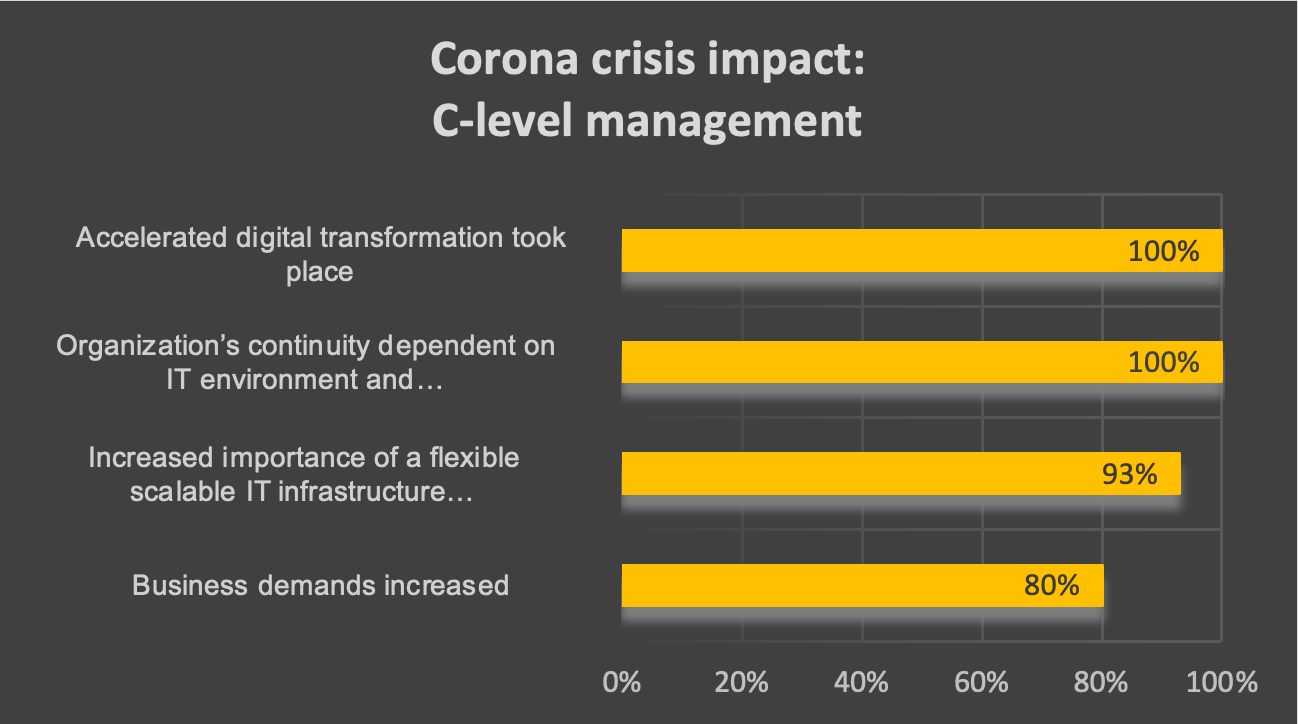
In recent months it has become painfully clear just how much organizations rely on their IT environment and business critical applications for business continuity. The new reality will have a visible impact on an organization’s IT landscape, now and in the near future.
Where do Dutch IT organizations stand six months after the Corona virus outbreak? A growing dependence on digital platforms has increased the importance of a flexible IT infrastructure. Faced with a challenging future, they are seeking ways to properly organize their infrastructure. This often results in parts of applications and processes, or even the entire infrastructure, being brought over to a (public) cloud.

Recent research from Sentia reveals that C-level managers are convinced that the Corona crisis is having a major impact on accelerating the digital transformation. The biggest challenge in this day and age is to create a secure home workplace for employees. That’s closely followed by a need to meet growing demands from the business, and questions around the availability of sufficient (internal) manpower to develop and manage systems, applications and data. Many companies are working on this – not always exclusively due to external factors – however, too few have everything 100% in order.
The 2022 IT Agenda: renewed priorities
The impact of the Corona crisis and the challenges it poses are also leading to a renewed focus on priorities for the IT agenda. Of all the respondents in Sentia’s research, C-level managers seem to experience the most challenges within the IT organization. Addressing these challenges brings renewed priorities for the next two years. These IT priorities can be summarized into two overarching themes: 'working safer and smarter' and 'creating an optimal end-user experience'. Specifically, the following four tasks comprise the IT agenda for 2022:
- creating a safe work-from-home space
- more focus on an organization-wide security approach
- the automation and digitization of work processes
- monitoring of application performance and the end-user experience
Investments in cloud and security
Although the Corona crisis represents a financial noose for many, in the short term the pandemic seems to have little effect on the IT budgets of Dutch IT organizations. A large majority of respondents indicate that budgets will not change for the time being. However, the expectation is that investments over the next two years will be in the cloud environment, security, and the (existing) IT infrastructure. These investments correspond to the core IT priorities for the next two years.
The study highlights (although not entirely unexpected) that many organizations will invest in a cloud environment in the coming years. In line with this, Gartner predicts strong growth in the (near) future, especially in public cloud adoption. Sentia’s research also highlights how the public cloud is considered an important factor in accelerating a digital transformation. However, transitioning to the (public) cloud does mean organizations will have to grapple with a dynamic, even more complex environment, over which they will need a tighter grip and more control. In this respect, continuous performance monitoring is crucial, as is guaranteeing the optimal availability of applications. Fortunately, based on the 2022 IT Agenda, we can conclude that IT departments are aware of these requirements.
Every organization has its reasons for switching to the public cloud, but of course, each one has also identified its own concerns and risks. For most companies, the flexibility of the public cloud is the key reason for switching over. A faster application of innovative technologies and cost savings are also factors in opting for the public cloud. However, making the switch also incurs a number of risks for organizations. Of these risks, vendor lock-in, security, compliance and regulation are noted as being the most important.
Software is eating the world
These changes don’t just happen behind the scenes either, they also occur in plain sight. The 'software is eating the world' concept, where organizations are becoming software companies, has also gained traction. For example, organizations which were, until recently, mostly known for their physical store concept are accelerating the transformation to an 'online platform'. That transition to having online platforms as a primary channel has a major impact on performance requirements for related applications, and possibly the end user experience. After all, consumers still want to experience uniform service quality - online, anywhere, anytime.
Over the past six months, virtually every IT department in the Netherlands has, to a greater or lesser extent, been confronted with this new IT reality. Every CIO has, in their own way, shifted emphasis and implemented necessary changes within their IT setup. They are all in the same boat and seem to agree on one thing: the new holy grail is a secure, smart way of working combined with the ultimate end user experience, all within a flexible IT environment.
Looking ahead, well-considered choices must be made on applying new technologies and innovations that are relevant to a future-proof IT organization. It does not stop there however. In order to be successful, the IT organization must be a critical part of the value chain. To achieve this, the CIO will have to collaborate throughout the organization, especially with the business. As the role increasingly shifts towards that of Digital Chief, these partners will have to start thinking and communicating in a different way. Understanding and attending to end user needs will be central in achieving these aims. The responsibity to create awareness of this falls to the CIO.



